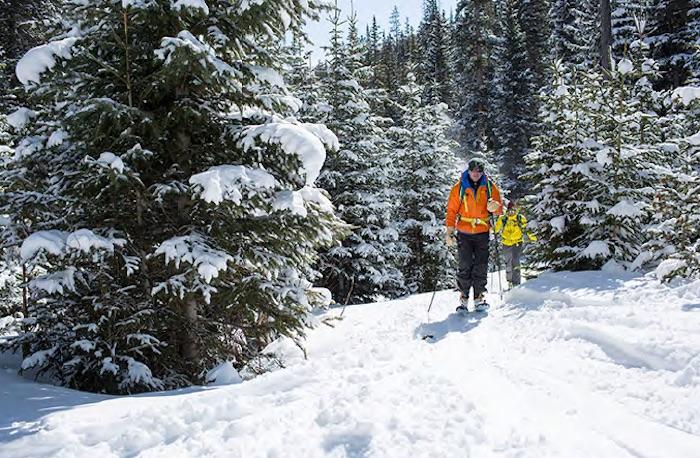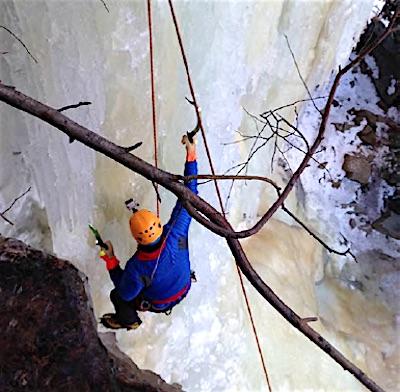
A winter’s visit to Rocky Mountain National Park could be filled with snowshoe explorations of the park/Joe Pyle
Editor's note: The following is an advertiser-sponsored article from Traveler's Essential Park Guide, Winter 2016-17.
It was just for a day, but the late-September snowstorm that closed Trail Ridge Road and Old Fall River Road in Rocky Mountain National Park sent a clear message: Winter can come quickly, hard, and heavy in the park, turning it into a winter wonderland with endless opportunities for exploration and enjoyment.
But just how to enjoy the park in winter is an enduring question. Embark on a snowshoe hike up to Emerald Lake? Kick-and-glide up Trail Ridge Road? Photograph wildlife in Horseshoe Park? Take a hike to Cub Lake? Or all of the above?
With a landscape and setting that might have inspired a Thomas Kinkade painting, Rocky Mountain National Park and charming Estes Park down below abound with memory-making wintry activities.
Here’s a glance at just some of the winter possibilities:
- Take a hike. On snowshoes, of course. This unique form of footwear was how Native Americans and original mountain men negotiated these mountains when the snows piled up. Fortunately, you don’t need to bend any tree saplings into snowshoes, as there are plenty of rentals available in Estes Park. Great trails to explore by snowshoe include Bear Lake and Glacier Gorge area trails. The Wild Basin area and Hidden Valley offer opportunities, but are busy on weekends and have limited parking at their trailheads. If you’re new to the sport, sign up for a ranger-led snowshoe hike in the park. These hikes are offered three days a week when conditions allow; check with park headquarters for the schedule (970 586-1206) or visit the park’s website, www.nps.gov/romo.
- Skip the snowshoes and kick-and-glide your way along Trail Ridge Road or Old Fall River Road. You’re sure to get an aerobic workout when you don cross-country skis, and the ability to cover more mileage quickly gets you out into the serene winter solitude that descends on the national park.
- If snowshoeing and cross-country skiing are a tad too sedate for you, go climb a waterfall. The bitter cold that wraps Rocky Mountain National Park at times during the winter months turns waterfalls into icefalls perfect for kicking your crampons and biting your ice axe into.

For the more adventurous, there are plenty of ice climbing routes in Rocky Mountain National Park/Brooke Burnham
- While the Hidden Valley ski area that once operated within the park’s boundaries is no more, that doesn’t mean you should leave your skis at home. Backcountry travelers comfortable in skinning up into the mountains and skiing back down their slopes have endless miles of terrain to explore.
- If you’re going to play in the snow or on the ice, you need to know how to do it safely, so consider signing up for an avalanche or winter survival course. And if you go into the backcountry, consider wearing an avalanche beacon and go with probe and shovel.
- While winter months see fewer Rocky Mountain National Park visitors, the wildlife remains plentiful no matter the temperature or the form of precipitation. And that’s why you should consider a wildlife safari, the one where you go armed with a camera. Just be sure you have a flashcard with lots of gigs of storage and an extra battery or two, as cold temperatures can zap a battery of its power surprisingly quickly (especially if you continually view your photos to see if you nailed your shot).
- Anglers know no off-season, and that works well with the many streams found in and around the national park. Most streams inside Rocky Mountain freeze during the winter so are not good places to fish. However, the Big Thompson River outside the park, below Lake Estes (Olympus Dam) would be a good river to fish. Ice fishing is allowed in all but waters designated closed by the park. There are some special regulations, so check with park officials before you cast.
- There are times when you might find snow-free trails on the eastern side of Rocky Mountain, and these are great to hike during the winter months. As with other winter sports, be sure to have eye protection from the sun, water to keep you from getting dehydrated (yes, it can happen in winter), layers of clothing so you can adjust as temperatures change or your activity level ebbs and flows, sunscreen, and snacks for energy.
- Spending a day in the park can be both rejuvenating … and exhausting. So treat yourself before calling it a day. Check into one of Estes Park’s spas to work out any kinks you might have picked up on the trails. You can find body wraps, deep massage, and hot rock treatments to sooth you and remove any residual aches.
- Of course, what would winter be without a festival? Plan your trip for mid-January and take part in the Estes Park Winter Festival & Winter Trails Day. There will be live music, a chili cookoff, bungee run, obstacle course, snowshoe demos, and adult beverages … for the adults!
- While the winter landscape might seem like the main attraction during your Rocky Mountain vacation, take some time to explore Estes Park. There are wonderful galleries to inspire your artistic side, restaurants to tempt your palate, three breweries, and even a winery and distillery providing a variety of culinary discoveries.
- While any day of the week is great for exploring the park and town, schedule a mid-week visit to avoid crowds and enjoy the prospect of untracked slopes and trails.
Best of all, at the end of a long day, head back to your lodge or cabin, light a fire (or turn one on) in the fireplace, and recount the winter wonders of this Rocky Mountain wonderland. Then starting planning tomorrow’s fun.



Comments
Our vacation ended on a bright note.. wefinally had a chance to see elk!! This was the bestwinter holiday vacationyet.. making memories. First time ever playing in the snow. lots of fun!